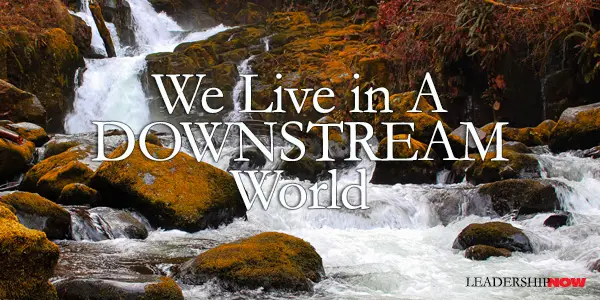 |
 |
04.20.20

We Live in A Downstream World
You and a friend are having a picnic by the side of a river. Suddenly you hear a shout from the direction of the water—a child is drowning. Without thinking, you both dive in, grab the child, and swim to shore. Before you can recover, you hear another child cry for help. You and your friend jump back in the river to rescue her as well. Then another struggling child drifts into sight … and another … and another. The two of you can barely keep up. Suddenly, you see your friend wading out of the water, seeming to leave you alone. “Where are you going?” you demand. Your friend answers, “I’m going upstream to tackle the guy who’s throwing all these kids in the water.” THIS metaphor sets the premise for Dan Heath’s book Upstream: The Quest to Solve Problems Before They Happen. We live in a downstream world. We have a bias for downstream action. We spend most of our time reacting to problems downstream rather than dealing with the source of the problem that is found upstream. Heath argues that “we should shift more of our energies upstream: personally, organizationally, nationally, and globally. We can—and we should—stop dealing with the symptoms of problems, again and again, and start fixing them.” That seems pretty obvious. So why don’t we? Time after time, we find ourselves reacting over and over again. Heath identifies three barriers to upstream thinking: Problem Blindness Problem blindness assumes that the problem is natural or inevitable, and there’s nothing you can do about it. And we shrug it off. “That’s just the way it is,” we conclude. So, we don’t try. “When we don’t see a problem, we can’t solve it. And that blindness can create passivity even in the face of enormous harm.” A Lack of Ownership Complacency. What problems do we see around us that we could fix, but don’t? Moving upstream requires that we take ownership of the issues personally. “I choose to fix this problem, not because it’s demanded of me, but because I can, and because it’s worth fixing.” Tunneling Tunneling is a condition where you find that “when people are juggling a lot of problems, they give up trying to solve them all. They adopt tunnel vision. There’s no long-term planning; there’s no strategic prioritization of issues.” When we are in a negative or scarcity mindset, we become “less insightful, less forward-thinking, less controlled.” Here are listed seven fundamental questions that upstream leaders must answer:
In clarifying these questions, Heath reveals some of the big issues through a wide variety of case studies that keep us from moving upstream. Part of what makes downstream efforts so popular is that the results are quite tangible. “Downstream efforts restore the previous state.” If my relationship is broken, and I fix it, the intervention was a success. If I do take preventative measures, I’m fixing what may or may not have happened. The issue arises, too, that I’m putting effort into something that is not broken. Is that necessary? We pay to fix problems, but we are not as keen to put money into preventing problems. “We can pay to fix problems once they happen, or we can pay in advance to prevent them. What we need are more businesses and social entrepreneurs who can figure out how to flip payment models to support the preventive approach.” There is uncertainty in fixing upstream problems, especially when they are not reoccurring. When preparing for a distant threat, it’s often difficult to tell if we are avoiding a disaster or preparing for something that will never happen. Is it worth the effort? “Organizations are constantly dealing with urgent short-term problems. Planning for speculative future ones is, by definition, not urgent. As a result, it’s hard to convene people. It’s hard to get funds authorized. It’s hard to convince people to collaborate when hardship hasn’t forced them to.” Heath asks, “How can you personally move upstream?” He recommends that we “be impatient for action but patient for outcomes.” We need to get moving, but often the change we seek takes time. Also, “macro starts with micro.” Break the action down. Get specific. And finally, “favor scoreboards over pills.” Think in terms of continuous improvement. “Data for learning” rather than “data for inspection.” Test and learn and test again. Upstream is a direction, not a destination. Any movement upstream is a step in the right direction. You can get a little ahead of the problem by or you can go further upstream and look for the more systemic issues. “When there’s a recurring problem in your life, go upstream.” When we don’t deal with problems upstream, we are destined to deal with them over and over again. 
Posted by Michael McKinney at 11:07 PM
|
BUILD YOUR KNOWLEDGE
 

How to Do Your Start-Up Right STRAIGHT TALK FOR START-UPS 
Grow Your Leadership Skills NEW AND UPCOMING LEADERSHIP BOOKS 
Leadership Minute BITE-SIZE CONCEPTS YOU CAN CHEW ON 
Classic Leadership Books BOOKS TO READ BEFORE YOU LEAD |